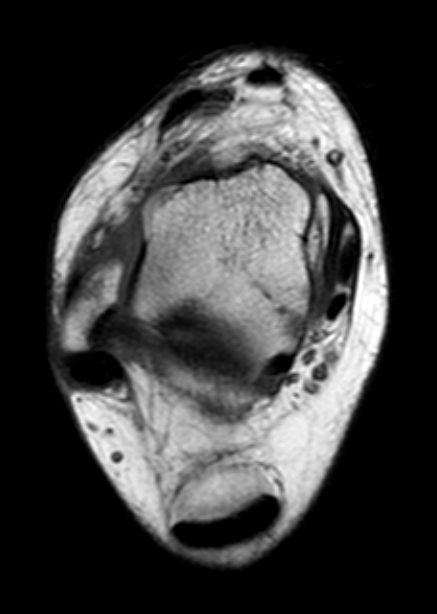Lateral ligament injuries are divided into
• High ankle sprain and
• Low ankle sprains
Low ankle sprain is considerably more common and is the injury typically referred to as a 'twisted ankle'. Three ligaments are considered in relation to low ankles sprain In practical terms however the posterior talofibular ligament is rarely torn and usually only where there is tibiotalar dislocation
The other two are the anterior talofibular ligament and calcaneofibular ligament
Of these, the calcaneofibular ligament is the more important as isolated tears of the anterior talofibular ligament do not usually rendered the ankle unstable
Many of these ligaments around the ankle are made of multiple strands and frequently separate bundles can be identified
Acute injuries to the anterior talofibular ligament results in loss of definition of the ligament which appears swollen and oedematous.
The normal ligament is approximately 3mm in thickness and 2cm in length.
Like other normal ligaments it should have low signal on both T1 and T2 weighted imaging.
Any significant inversion injury where the patient has difficulty in weight bearing afterwards is likely to indicate a tear of this ligament.
Clinically, tenderness is below and anterior to the lateral malleolus.
Classification systems have been proposed but correlation with clinical findings and outcome is not clear cut.
Fluid extravasation into the extra-articular soft tissues is suggestive of complete rupture particularly if coupled with obvious discontinuity.
Chronic changes include a diffusely thickened or thinned ligament
most heal but some result in synovial debris in the area of the ankle joint below it, called the anterolateral gutter
Chronic synovitis here is referred to as anterolateral impingement
Assessment of the calcaneofibular ligament is difficult as it runs in both the sagittal and, more proximally, the axial plane
It is easiest to visualise on coronal T1 images deep to the peroneal tendons
Similar to the anterior talofibular ligament, acute injury results in swelling and increased signal.
It is often difficult to differentiate partial from complete injuries.
Complete rupture of the ligament is associated with extravasation of fluid into the peroneal sheath which may assist with diagnosis.
In the chronic phase, an injured ligament can become thickened or thinned.
Under these circumstances, ultrasound can be helpful in differentiating and normal thin ligament from a previously torn thin ligament
As it provides better depiction of the internal structure of the ligament
Loss of this pattern is indicative of injury. Ultrasound has the advantages of allowing the ligament to be stressed which may demonstrate a more occult injury.
Injuries to the calcaneofibular ligament are most frequent at the fibular insertion
An important indirect US signs of tear are: absence of tightening of the calcaneo-ligament during a dynamic examination with dorsal flexion of the ankle
The posterior component of the lateral ligament complex is rarely torn
It contains multiple laminations
When seen in sagittal section, it can be misconstrued as a loose body in the posterior joint space
HIGH ANKLE SPRAIN
High ankle sprain is primarily concerned with injuries to the anterior tibiofibular ligament and syndesmotic ligaments
Syndesmotic sprains generally involve the anterior tibio-fibular ligament and are secondary to an eversion ankle injury.
Injury can occur in heavy contact sports such as soccer or American football and rugby.
The spectrum includes injuries to the:
• anterior inferior tibiofibular ligament,
• the interosseous ligament,
• the interosseous membrane and
• the superficial and deep components of the posterior tibiofibular ligament.
The anterior inferior tibiofibular ligament AITFL attaches medially on the anterolateral tubercle of the tibia and then passes laterally and inferiorly to attach to the distal fibula. It is often multifasicular and the lower most component is sometimes referred to as the accessory or Bassett’s ligament.
They are accurately detected by both ultrasound and MRI. Findings include:
• hypoechoic ligament thickening
•, local hyperaemia,
• ligament defect, and/or
• ligament/bone avulsion.
• A convex configuration of the ligament is a useful sign of injury on both US and MRI.
An associated fibular fracture is best appreciated on plain radiography.
The anterior components are more significant than the posterior components which include the posterior tibiofibular and transverse ligaments.
The anterior tibiofibular ligament is a band like ligament comprising several fascicles.
The inferior portion tends to become injured first.
The interosseous ligaments comprise a number of low signal stripes
that pass obliquely inferiorly from the tibia to the fibula at the lower end of the interosseous membrane.
There is a fluid-filled recess extending from the main tibiotalar joint towards the lower margin of the interosseous membrane.
This is generally no more than 6-8 mm in length this fluid extends more proximally, a tear of the interosseous membrane is likely
Injuries to the anterior talofibular ligament are identified by thickening, loss of definition and surrounding soft tissue oedema
Chronic changes are seen as the thickened ligament with a convex anterior margin.



